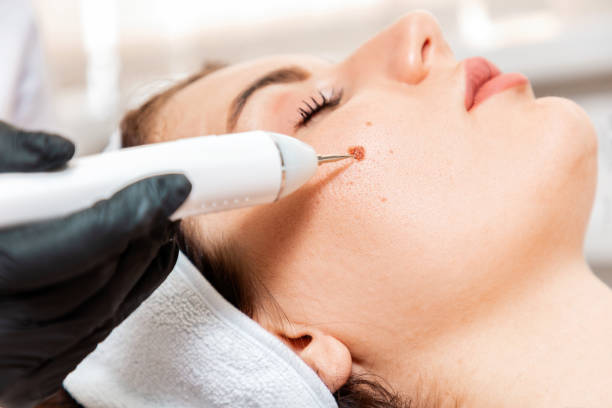Hyperpigmentation can be caused by sun damage, inflammation, or other skin injuries, including those related to acne vulgaris. 854 People with darker skin tones are more prone to hyperpigmentation, especially with excess sun exposure.
Many forms of hyperpigmentation are caused by an excess production of melanin. Hyperpigmentation can be diffuse or focal, affecting such areas as the face and the back of the hands. Melanin is produced by melanocytes at the lower layer of the epidermis. Melanin is a class of pigment responsible for producing color in the body in places such as the eyes, skin, and hair. The process of melanin synthesis (melanogenesis) starts with the oxidation of L-tyrosine to L-DOPA by the enzyme tyrosine hydroxylase, then to L-Dopaquinone and Dopachrome, which forms melanin.
As the body ages, melanocyte distribution becomes less diffuse and its regulation less controlled by the body. UV light stimulates melanocyte activity, and where concentration of the cells is greater, hyperpigmentation occurs. Another form of hyperpigmentation is post inflammatory hyperpigmentation. These are dark and discoloured spots that appear on the skin following acne that has healed.
Oral medication with procyanidin plus vitamins A, C, and E also shows promise as safe and effective for epidermal melasma. In an 8-week randomized, double-blind, placebo-controlled trial in 56 Filipino women, treatment was associated with significant improvements in the left and right malar regions, and was safe and well tolerated. Other treatments that do not involve topical agents are also available, including fraction lasers and dermabrasion.
There is a wide range of depigmenting treatments used for hyperpigmentation conditions, and responses to most are variable.
Many topical treatments disrupt the synthesis of melanin by inhibiting the enzyme tyrosine hydroxylase.
Hyperpigmentation does not disappear naturally, contrary to popular belief. It must be treated. The Pond’s White Beauty Daily Spotless Lightening Creme is recommended to treat hyperpigmentation. It contains the revolutionary Genwhite Formula and is absorbed deeply into the skin to immediately fade dark spots. It’s non-greasy and has SPF 20 PA. Over time it will even out your skin tone.
Lemons
lemon, rich in citric acid is a bleaching agent. Use freshly squeezed lemon juice to your face for 5-7 minutes. Use warm water to rinse it off. This process should be repeated several times daily until you start to see results. Lemon, because of its bleaching properties, helps to even out skin tone. This is a great way to treat hyperpigmentation.
Turmeric
How many times have you heard your grandmother tell you to use turmeric to get healthier skin? She was right all along. Curcuminoids are compounds with medicinal properties that can be found in turmeric. They help to even out skin color by reducing excess melanin production.
Honey and milk
The lactic acid found in milk can be used continuously to remove dead skin. Honey has a therapeutic effect on skin, as it moisturizes and nourishes. This combination of honey with milk is a great way to effectively treat hyperpigmentation. Apply honey and milk to your skin. Allow the mixture to dry for a while before wiping it off with warm water.




